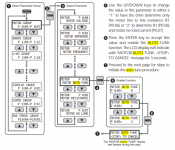Saturn_Europa
Senior Member
- Location
- Fishing Industry
- Occupation
- Electrician Limited License NC, QMED Electrician
I work on a fishing boat. There are 3 twenty horse power motors that drive high pressure pumps into a common header. The header is connected to pressure washer wands thru out the factory.
I installed a new motor: https://www.radwell.com/en-US/Buy/TOSHIBA/TOSHIBA/0204XDSB42A-P/ its a 256T frame.
The motors are supplied by 3 identical drives. Durapulse GS3-4020 . I did not change any settings when I installed a the new motor. The voltage, HP, RPM matched the old motor that was removed.
The motor will not start with the Volts/Herts setting (2.00) on 01 High Starting Torque. The plc is giving a command of 34 hertz, the output hertz is 0.5 and the amps are 55. The motor is shaft is barely turning and the drive faults out. I disconnected the lovejoy from the pump and tried to run the motor unloaded. Same thing. I thought the motor was singling phasing at first. But everything is correct.
When I set 2.00 to 00 General Purpose the motor starts right up and follows the commanded hertz.
The other 2 motors are set to High Starting Torque and have not been giving me a problem.
Any ideas on why the new motor does not like the High Starting Torque.
The pump is similar to this:
 www.catpumps.com
www.catpumps.com
I installed a new motor: https://www.radwell.com/en-US/Buy/TOSHIBA/TOSHIBA/0204XDSB42A-P/ its a 256T frame.
The motors are supplied by 3 identical drives. Durapulse GS3-4020 . I did not change any settings when I installed a the new motor. The voltage, HP, RPM matched the old motor that was removed.
The motor will not start with the Volts/Herts setting (2.00) on 01 High Starting Torque. The plc is giving a command of 34 hertz, the output hertz is 0.5 and the amps are 55. The motor is shaft is barely turning and the drive faults out. I disconnected the lovejoy from the pump and tried to run the motor unloaded. Same thing. I thought the motor was singling phasing at first. But everything is correct.
When I set 2.00 to 00 General Purpose the motor starts right up and follows the commanded hertz.
The other 2 motors are set to High Starting Torque and have not been giving me a problem.
Any ideas on why the new motor does not like the High Starting Torque.
The pump is similar to this:


